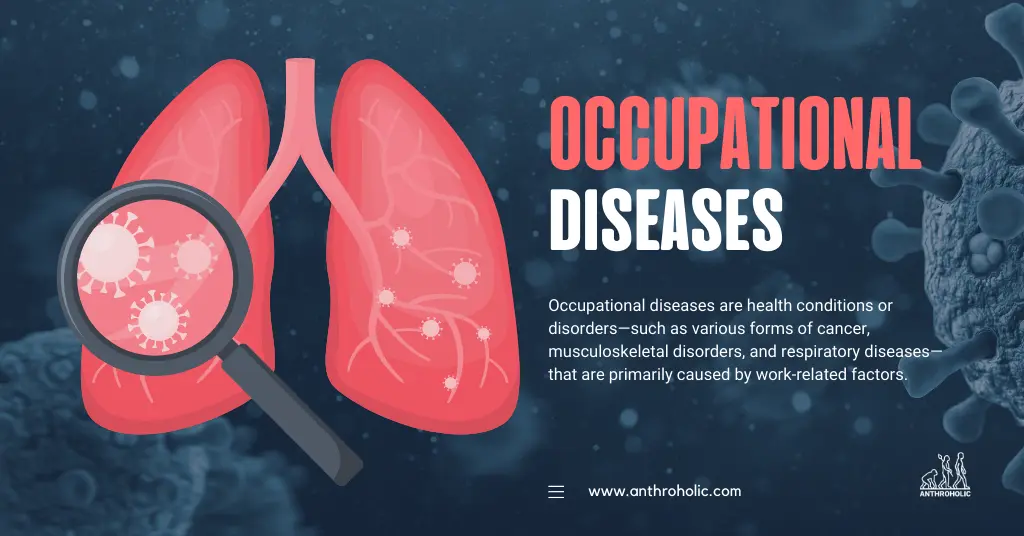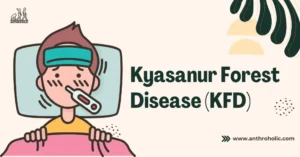AI Answer Evaluation Platform Live Now. Try Free Answer Evaluation Now
Occupational Diseases
Occupational diseases are health conditions or disorders—such as various forms of cancer, musculoskeletal disorders, and respiratory diseases—that are primarily caused by work-related factors. These conditions may arise from exposure to physical, chemical, biological, or psychosocial hazards in the workplace.

Classification of Occupational Diseases
Occupational diseases can be classified according to their cause:
- Physical Causes: These include injuries caused by repetitive motion, vibration, extreme temperatures, noise, and radiation.
- Chemical Causes: Diseases can result from exposure to various toxic or harmful substances like lead, asbestos, pesticides, or solvents.
- Biological Causes: These diseases stem from exposure to biological agents such as bacteria, viruses, and fungi.
- Psychosocial Causes: Stress, harassment, and bullying at work can cause several psychological disorders.
Common Occupational Diseases
Musculoskeletal Disorders
Musculoskeletal disorders (MSDs) are conditions that can affect your muscles, bones, and joints. Examples include:
- Carpal Tunnel Syndrome
- Tendonitis
- Muscle / Tendon strain
- Degenerative Disc Disease
- Tension Neck Syndrome
Respiratory Diseases
Exposure to harmful substances and dust in the workplace can lead to respiratory diseases, such as:
- Occupational Asthma
- Silicosis
- Asbestosis
- Chronic Obstructive Pulmonary Disease (COPD)
- Mesothelioma
Skin Diseases
Contact with certain chemicals or materials can cause various skin diseases. Common ones include:
- Contact Dermatitis
- Skin Cancer
- Chemical Burns
- Urticaria
Noise-Induced Hearing Loss
Constant exposure to loud noise can result in noise-induced hearing loss, a condition that often goes undiagnosed until the individual has lost a significant amount of hearing.
Psychosocial Disorders
These are conditions that result from stress, harassment, or other adverse work conditions:
- Anxiety and Depression
- Post-Traumatic Stress Disorder (PTSD)
- Burnout Syndrome
Prevention and Control Measures
There are several measures that can be taken to prevent and control occupational diseases. These include:
- Hazard Identification and Risk Assessment: Identify potential hazards in the workplace and evaluate the risks associated with them.
- Implement Control Measures: Based on the identified risks, implement appropriate control measures such as use of personal protective equipment (PPE), modification of work processes, and installation of safety devices.
- Health Surveillance: Regular medical check-ups can help in early detection and treatment of occupational diseases.
- Training and Education: Educate workers about potential hazards and their prevention.
- Emergency Preparedness: Plan for emergencies by having evacuation procedures and first-aid facilities in place.
Global Perspective
Occupational diseases significantly impact the global workforce. As per the International Labour Organization (ILO), work-related diseases result in an estimated 2.78 million deaths per year. The following table gives a snapshot of the situation.
| Region | Estimated Work-Related Deaths per Year |
|---|---|
| Asia | 1.36 million |
| Africa | 380,000 |
| Europe | 350,000 |
| Americas | 360,000 |
These figures underline the necessity for a global, concerted effort in prevention, recognition, and treatment of occupational diseases.
Legal Aspects and Workers’ Rights
Workers who are diagnosed with occupational diseases often have legal rights and remedies, which may vary depending on the jurisdiction.
Compensation
In most countries, workers suffering from occupational diseases are entitled to compensation for their medical expenses, loss of income, and other related costs. This usually falls under workers’ compensation insurance, which employers are mandated to provide.
Safe Work Environment
All workers have a right to a safe and healthy work environment. Employers have a legal obligation to ensure that their workplaces do not pose a risk to the health and safety of their employees. This includes proper maintenance of equipment, safe handling and storage of chemicals, adequate training for all employees, and implementation of safety measures to mitigate risks.
Right to Refuse Unsafe Work
Workers also have the right to refuse work that they believe is unsafe. This can apply if the worker believes that the task poses an immediate risk to their health and safety, or if it could cause long-term harm, such as an occupational disease.
Protection against Retaliation
Workers who report unsafe conditions, refuse unsafe work, or claim compensation for an occupational disease are protected from retaliation by their employer. This means that they cannot be fired, demoted, or subjected to any other negative consequences for exercising their rights.
Treatment of Occupational Diseases
Occupational diseases require medical intervention, often involving a multidisciplinary approach that includes medical treatment, occupational therapy, and lifestyle changes. Treatment usually focuses on managing symptoms, slowing the progression of the disease, and helping the affected worker maintain their quality of life. It may include:
- Medication: This could include painkillers, anti-inflammatory drugs, or medication to manage specific symptoms.
- Therapy: Physical or occupational therapy can help manage symptoms and improve the worker’s ability to perform daily tasks.
- Lifestyle Changes: This could involve changes in diet, exercise, stress management, and cessation of smoking or alcohol.
- Workplace Modifications: If the worker is able to continue working, modifications may need to be made to their work environment or duties to accommodate their condition.
The Role of Occupational Health Services
Occupational health services play a crucial role in preventing and managing occupational diseases. They do this through:
- Preventive Services: These include risk assessments, implementation of preventive measures, and health surveillance.
- Diagnostic Services: If a worker becomes ill, occupational health services can help diagnose whether the illness is work-related.
- Treatment and Rehabilitation Services: If a worker is diagnosed with an occupational disease, occupational health services can provide or coordinate their treatment and help them return to work, if possible.
- Counseling and Support Services: These services can help workers cope with the emotional and psychological impact of their disease.
Future Perspective: The Impact of Emerging Technologies
Emerging technologies such as Artificial Intelligence (AI), Internet of Things (IoT), and robotics hold great promise in the prevention and management of occupational diseases. For instance, IoT devices can monitor the work environment in real-time and alert workers to potential hazards. AI can help in the early detection of diseases by analyzing health data, while robotics can reduce the need for humans to perform dangerous tasks. However, these technologies also pose new risks, such as psychological stress and privacy concerns, which need to be managed carefully.
Conclusion
While occupational diseases pose a significant threat to the global workforce, they are largely preventable. Effective prevention and management of occupational diseases require a coordinated effort from employers, workers, health professionals, and policy makers. It is crucial to continue investing in research, technology, and policy measures to further improve workplace health and safety. Despite the challenges, the goal of a world where every worker can work in a safe and healthy environment is within our reach.



